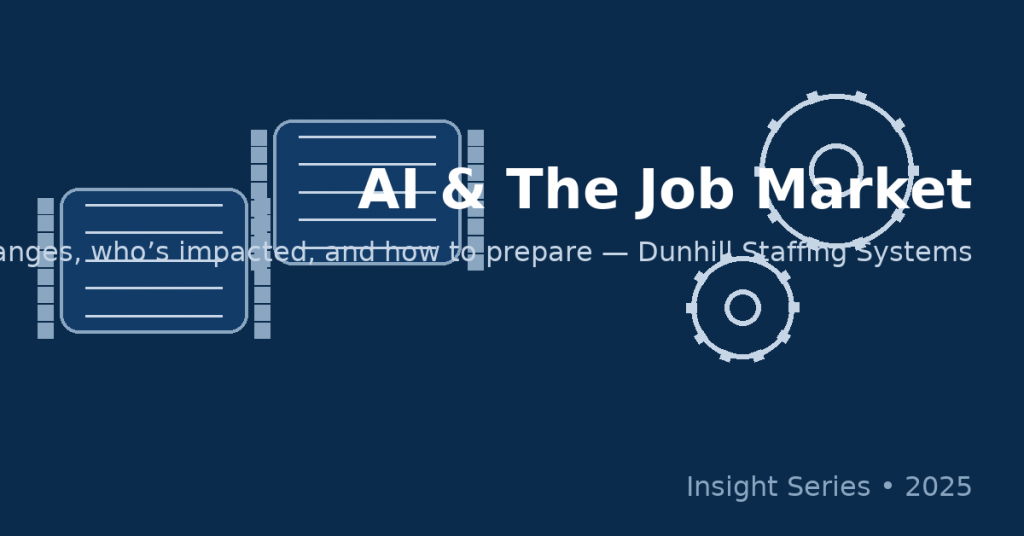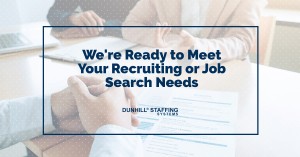AI and the Job Market: What Changes, Who’s Impacted, and How to Prepare
Artificial intelligence is no longer a distant forecast—it’s a present force reshaping how work gets done, which jobs grow, and how careers evolve. At the American Staffing Association’s recent annual conference, session after session explored AI’s impact on the world of work, workers, and workforce development. As a staffing partner, Dunhill Staffing Systems is focused on helping employers and candidates navigate this shift—not with hype, but with practical steps that deliver value.
What’s Changing (and Why It Matters)
AI is accelerating three trends already underway:
- Automation of routine tasks (data entry, document processing, scheduling), boosting throughput but changing role design.
- Decision support at scale (forecasting, quality checks, pricing, risk), improving productivity where data are rich.
- New human–machine workflows that blend people, software, and sensors—from plant floors to accounting teams to customer operations.
The question isn’t whether AI will affect your organization; it’s where first, how fast, and how you’ll respond.
Industries Likely to See the Biggest Shifts
Positive, near-term productivity gains are expected in:
- Manufacturing & aerospace: computer vision and predictive maintenance; AI-assisted QA; planning and scheduling optimization.
- Professional services (accounting, finance): reconciliation, reporting, anomaly detection, and research summaries.
- Customer operations & sales: AI copilots, knowledge retrieval, and tailored outreach at scale.
Longer-term transformation or pressure will build in:
- Clerical/administrative support: document prep, calendaring, intake, and basic correspondence are highly automatable.
- Back-office operations: repetitive workflows in claims, AP/AR, and standard compliance checks.
- Low-complexity content work: templated drafts, summaries, and basic creative tasks will be augmented substantially.
Roles Most Exposed—and Most Enabled
High exposure (task automation): data entry clerks, basic accounting assistants, scheduling coordinators, junior support roles heavy on repetitive workflows.
High enablement (task augmentation): engineers, quality technicians, analysts, project managers, sales reps—roles where AI accelerates research, coding/debugging, documentation, forecasting, and communication.
Net new demand: AI product owners, prompt engineers, model/ML ops, data stewards, validation/audit specialists, and change-management leaders.
Timing: What to Expect and When
Based on consensus across leading researchers and industry reports, a practical horizon looks like this:
- 12–24 months: broad piloting and adoption of AI copilots in office tools; targeted automation of high-volume tasks; measurable productivity lifts in teams that integrate AI into daily workflows.
- 3–5 years: deeper re-design of roles and processes; expanding use on plant floors and in field operations; new job families around governance, safety, and validation.
- 5–10 years: compounding effects—organizations that invest early will widen the gap in speed, cost, and quality; laggards face talent and margin pressure.
What Experts Are Saying
- Erik Brynjolfsson (Stanford HAI) argues AI is most powerful when it complements humans, lifting productivity and wages where organizations redesign work to capture the gains.
- Daron Acemoglu (MIT) warns about “so-so automation”—deployments that replace labor without creating much new value—advocating for human-centric design and skill investment.
- Carl Benedikt Frey (Oxford) highlights differential exposure: tasks within jobs—not whole occupations—are increasingly automatable, implying reskilling can meaningfully shift outcomes.
- McKinsey Global Institute and the World Economic Forum forecast substantial task change across most occupations, with net job effects dependent on innovation, demand, and policy choices.
Three Strategies to Prepare—For Companies and Individuals
1) Redesign Work, Not Just Jobs
Map tasks, not titles. Identify where AI can take the first pass (drafts, checks, summaries), and where humans create value (judgment, relationships, creativity). Pilot “human-in-the-loop” workflows with clear quality gates and metrics.
2) Invest in Skills and Governance
Companies: build an internal academy covering data literacy, prompt design, and domain-specific AI use. Create lightweight governance—approved tools, privacy standards, review protocols. Individuals: prioritize skills that compound with AI—analysis, systems thinking, communication, and domain depth.
3) Measure the Value (and Share the Wins)
Track cycle time, error rates, throughput, and customer satisfaction before/after AI pilots. Reinvest the gains in people—upskilling, new career ladders, and meaningful work redesign—to sustain adoption.
For additional perspective on AI’s workforce impact and preparation, see resources from Stanford HAI, the WEF Future of Jobs project, and McKinsey Global Institute.
How Dunhill Staffing Systems Helps Employers
Role re-design & workforce planning: We translate your business goals into skills, tasks, and hiring profiles for the next 12–36 months—especially in engineering, manufacturing, accounting, and operations.
Build vs. buy talent strategy: We help decide where to train internal teams, where to hire new skills (AI ops, data stewardship, automation technicians), and where to use contract or RPO models to scale quickly.
Passive-talent access: Our recruiters engage high-demand talent not active on job boards, presenting your roles with clarity around impact, tools, growth, and governance—what modern candidates want to know.
How Dunhill Supports Candidates
Career mapping with AI in mind: We help engineers, accountants, managers, and skilled technicians highlight achievements AI will amplify—not replace. Résumé tweaks and interview prep focus on human strengths plus “AI-accelerated” outcomes.
Temp-to-perm and project pathways: For professionals exploring AI-adjacent roles, we use contract or temp-to-hire to de-risk transitions, build new experience, and convert when the fit is proven.
Bottom Line
AI will not replace people—but people and organizations who use AI will outperform those who don’t. The winners will be the ones who redesign work thoughtfully, invest in skills, and measure real outcomes. Dunhill Staffing Systems is here to help employers and professionals turn AI from uncertainty into advantage.







